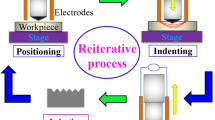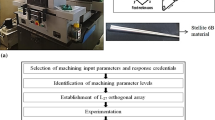Abstract
Micro-electrical discharge machining (micro-EDM) has an issue of uneven tool electrode wear that seriously affects the micro-hole accuracy. However, the mechanism of uneven tool electrode wear remains unclear. In this study, the uneven tool electrode wear mechanism has been studied both theoretically and experimentally. It was first discovered that the ultrafine debris particles produced by the EDM spark play a critical role in uneven tool electrode wear. A theoretical model was established to reveal the movement and the distribution of the debris by employing Einstein’s tea leaf paradox i.e., classic secondary flow theory and the electrophoretic theory. According to this model, when the polarity is positive, the ultrafine debris aggregates gradually and adheres onto the bottom of the micro-hole, thereby a debris layer of a parabolic profile is formed progressively. This dynamic debris layer shields the material to be removed by the EDM spark. As a result, the tip of the tool electrode is unevenly worn into a conical concavity shape. Conversely, under negative polarity, the tip of the tool electrode is unevenly worn into a conical shape. A set of experiments was performed to verify the model and the results agreed well with the predicted phenomena. Subsequently, a novel approach is proposed to eliminate the uneven tool electrode wear by reversing pulse polarity in a repetitive manner. Using this method, uneven tool electrode wear can be avoided and high accuracy micro-holes without the features of a cone and/or conical concavity can be obtained.



















Similar content being viewed by others
Data availability statement
The data used to support the findings of this study have not been made available.
References
Masuzawa, T. (2000). State of the art of micromachining. CIRP Annals-Manufacturing Technology, 49, 473–488.
Hasan, M., Zhao, J., & Jiang, Z. (2017). A review of modern advancements in micro drilling techniques. Journal of Manufacturing Processes, 29, 343–375.
Chu, W. S., Kim, C. S., Lee, H. T., Choi, J. O., Park, J. I., Song, J. H., Jang, K. H., & Ahn, S. H. (2014). Hybrid manufacturing in micro/nano scale: A Review. International Journal of Precision Engineering and Manufacturing-Green Technology, 1(1), 75–92.
Nasrollahi, V., Penchev, P., Batal, A., Le, H., Dimov, S., & Kim, K. (2020). Laser drilling with a top-hat beam of micro-scale high aspect ratio holes in silicon nitride. Journal of Materials Processing Technology, 281, 116636.
Heo, J., Min, H., & Lee, M. (2015). Laser micromachining of permalloy for fine metal mask. International Journal of Precision Engineering and Manufacturing-Green Technology, 2(3), 225–230.
Chen, X., Zhu, J., Xu, Z., & Su, G. (2021). Modeling and experimental research on the evolution process of micro through-slit array generated with masked jet electrochemical machining. Journal of Materials Processing Technology, 298, 117304.
Chung, D. K., & Chu, C. N. (2015). Effect of inductance in micro EDM using high frequency bipolar pulse generator. International Journal of Precision Engineering and Manufacturing-Green Technology, 2(3), 299–303.
Islam, M. M., Li, C. P., & Ko, T. J. (2017). Dry electrical discharge machining for deburring drilled holes in CFRP composite. International Journal of Precision Engineering and Manufacturing-Green Technology, 4(2), 194–154.
Zia, M. K., Pervaiz, S., Anwar, S., & Samad, W. A. (2019). Reviewing sustainability interpretation of electrical discharge machining process using triple bottom line approach. International Journal of Precision Engineering and Manufacturing-Green Technology, 6(5), 931–945.
Tsai, Y. Y. (2004). An index to evaluate the wear resistance of the electrode in micro-EDM. Journal of Materials Processing Technology, 149(1–3), 304–309.
Li, G., Natsu, W., & Yu, Z. (2019). Study on quantitative estimation of bubble behavior in micro hole drilling with EDM. International Journal of Machine Tools and Manufacture, 146, 103437.
Ferraris, E., Castiglioni, V., Ceyssens, F., Annoni, M., Lauwers, B., & Reynaerts, D. (2013). EDM drilling of ultra-high aspect ratio micro holes with insulated tools. CIRP Annals-Manufacturing Technology, 62(1), 191–194.
Wang, Y., Zhao, F., & Jin, W. (2009). Wear-resist electrodes for micro-EDM. Chinese Journal of Aeronautics, 22(3), 339–342.
Kumar, R., & Singh, I. (2019). A modified electrode design for improving process performance of electric discharge drilling. Journal of Materials Processing Technology, 264, 211–219.
D’Urso, G., Longo, M., Maccarini, G., & Ravasio, C. (2011). Electrical discharge machining of micro holes on titanium sheets. In Proceedings of the ASME Design Engineering Technical Conference (pp. 417–424).
Jahan, M. P., Wong, Y. S., & Rahman, M. (2009). A study on the quality micro-hole machining of tungsten carbide by micro-EDM process using transistor and RC-type pulse generator. Journal of Materials Processing Technology, 209(4), 1706–1716.
Yan, M.-T., Fang, G.-R., & Yi-Ting, L. (2013). An experimental study on micro wire-EDM of polycrystalline diamond using a novel pulse generator. International Journal of Advanced Manufacturing Technology, 66, 1633–1640.
Yang, J., Yang, F., Hua, H., Cao, Y., Li, C., & Fang, B. (2018). A bipolar pulse power generator for micro-EDM. Procedia CIRP, 68, 620–624.
Huan, L., Jicheng, B., Yan, C., Guozheng, Z., & Shaojie, H. (2020). Micro-electrode wear and compensation to ensure the dimensional consistency accuracy of micro-hole array in micro-EDM drilling. International Journal of Advanced Manufacturing Technology, 111(9–10), 2653–2665.
Mustafa, Ay., Ulaş, Ç., & Ahmet, H. (2013). Optimization of micro-EDM drilling of inconel 718 superalloy. International Journal of Advanced Manufacturing Technology, 66(5–8), 1015–1023.
Pei, J., Zhang, L., Du, J., Zhuang, X., Zhou, Z., Wu, S., & Zhu, Y. (2017). A model of tool wear in electrical discharge machining process based on electromagnetic theory. International Journal of Machine Tools and Manufacture, 117, 31–41.
Jeong, Y. H., & Min, B. K. (2007). Geometry prediction of EDM-drilled holes and tool electrode shapes of micro-EDM process using simulation. International Journal of Machine Tools and Manufacture, 47(12–13), 1817–1826.
Aligiri, E., Yeo, S. H., & Tan, P. C. (2010). A new tool wear compensation method based on real-time estimation of material removal volume in micro-EDM. Journal of Materials Processing Technology, 210(15), 2292–2303.
Malayath, G., Katta, S., Sidpara, A., & Deb, S. (2019). Length-wise tool wear compensation for micro electric discharge drilling of blind holes. Measurement, 134, 888–896.
Pham, D. T., Ivanov, A., Bigot, S., Popov, K., & Dimov, S. (2007). An investigation of tube and rod electrode wear in micro EDM drilling. International Journal of Advanced Manufacturing Technology, 33(1–2), 103–109.
Mitsui, K., & Mahardika, M. (2008). A new method for monitoring micro-electric discharge machining process. International Journal of Machine Tools and Manufacture, 48(3–4), 446–458.
Ekmekci, B., Sayar, A., Opöz, T. T., & Erden, A. (2009). Geometry and surface damage in micro electrical discharge machining of micro-holes. Journal of Micromechanics and Microengineering, 19, 105030.
Schacht, B., Kruth, J., Lauwers, B., & Vanherck, P. (2004). The skin-effect in ferromagnetic electrodes for wire-EDM. International Journal of Advanced Manufacturing Technology, 23(11–12), 794–799.
Li, X., Wang, Y., Liu, Y., & Zhao, F. (2019). Research on shape changes in cylinder electrodes incident to micro-EDM. Advances in Materials Science and Engineering, 2019(4), 1–11.
Ekmekci, B., & Sayar, A. (2013). Debris and consequences in micro electric discharge machining of micro-holes. International Journal of Machine Tools and Manufacture, 65, 58–67.
Ichikawa, T., & Natsu, W. (2013). Investigation of machining characteristics of micro-EDM with ultrasonically vibrated machining fluid under ultra-small discharge energy. International Journal of Electrical Machining, 18, 1–7.
Ikeno, J., Tani, Y., & Sato, H. (1990). Nanometer grinding using ultrafine abrasive pellets—manufacture of pellets applying electrophoretic deposition. CIRP Annals-Manufacturing Technology, 39(1), 341–344.
Mangelsdorf, C. S., & White, L. R. (1992). Electrophoretic mobility of a spherical colloidal particle in an oscillating electric field. Journal of the Chemical Society Faraday Transactions, 88(24), 3567–3581.
Einstein, A. (1926). Die ursache der manderbildung der flulufe und des sogenannten baerschen gesetze. Naturwissenschaften, 14(11), 223–224.
Acknowledgements
The work described in this study was supported by the National Natural Science Foundation of China (Grant nos. 52175387 and 52075104). We sincerely thank Xinlang Zuo for their support with the SEM and EDS (the China Electronic Product Reliability and Environmental Testing Research Institute).
Author information
Authors and Affiliations
Corresponding author
Ethics declarations
Conflict of interest
The authors declare that they have no known competing financial interests or personal relationships that could have appeared to influence the work reported in this paper.
Additional information
Publisher's Note
Springer Nature remains neutral with regard to jurisdictional claims in published maps and institutional affiliations.
Rights and permissions
Springer Nature or its licensor (e.g. a society or other partner) holds exclusive rights to this article under a publishing agreement with the author(s) or other rightsholder(s); author self-archiving of the accepted manuscript version of this article is solely governed by the terms of such publishing agreement and applicable law.
About this article
Cite this article
Zou, Z., Zhang, X., Chan, K. et al. An Analysis of the Uneven Tool Electrode Wear Mechanism in the Micro-electrical Discharge Machining Process. Int. J. of Precis. Eng. and Manuf.-Green Tech. 10, 1375–1391 (2023). https://doi.org/10.1007/s40684-022-00499-9
Received:
Revised:
Accepted:
Published:
Issue Date:
DOI: https://doi.org/10.1007/s40684-022-00499-9




